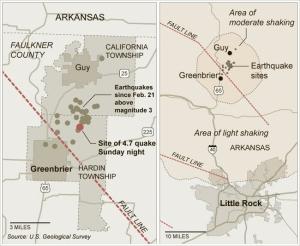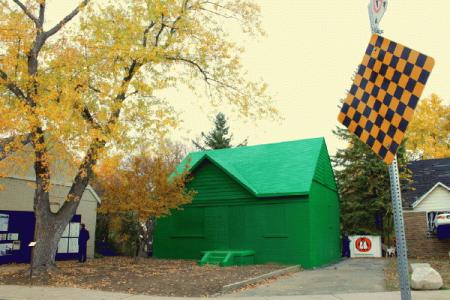Word is that bread trucks and lunch-meat trucks have been dispatched to deal with this incident.
Author: Richard
Swarm of earthquakes bedevils Arkansas
The earth is restless in Arkansas – remarkably so – and no one is quite sure why. Since last September, more than 800 earthquakes have rocked the central Arkansas town of Greenbrier, and residents are becoming “unsettled by the[ir] increasing severity and lack of warning.” 1
The Huffington Post reports that
earthquakes ranging in magnitude from 1.8 to 3.8 have
rattled the north-central Arkansas cities of Greenbrier and Guy this
week, and the cause is unknown.The U.S. Geological Survey has reported more than 30 earthquakes in
the area since Sunday [February 13], including a magnitude 3.8 quake Thursday morning
and at least 16 others occurring Wednesday, two of which were magnitude
3.2 and 3.5.
The latest quake to shake the area was
A 4.7-magnitude earthquake that researchers described as the largest in
Arkansas in 35 years […] There were no reports of major damage, though some residents spoke of
dislodged screen doors and cracked ceilings. Damage or not, some said
this was the longest and scariest quake yet.
While experts are largely at a loss to explain this swarm of earthquakes, some scientists have suggested a connection to natural gas drilling in the area:
Researchers with the Arkansas Geological Survey have pointed out
spatial and temporal relationships between the earthquakes and the use
of injection wells, which are used to dispose of the wastewater left
over from gas drilling. (Researchers see no such correlation between the
quakes and the drilling itself, a process called hydraulic fracturing.)
While a possible connection is being studied, the Arkansas Oil and Gas
Commission has imposed an emergency moratorium on the drilling of new
injection wells in the area.
You can read more here. (Map from NYT.)
Wormlike “Walking Cactus” Fossil Discovered in China
The odd headline of the hour. From our correspondents at National Geographic:
Fossils of an ancient, spiny creature dubbed a “walking cactus” have been found in China, a new study says.
The 2.4-inch-long (6-centimeter-long) Diania cactiformis
had a worm-like body and ten pairs of armored and likely jointed legs.
It would have lived about 500 million years ago during a period of rapid
evolution called the Cambrian explosion.
You can read the rest – and see an artist’s recreation of this bizarre creature – here.
The U.S. government’s 1958 “what-if” film about nuclear war
… is entitled “The Power of Decision,” and was recently declassified. It
may be the first (and perhaps the only) U.S. government film depicting
the Cold War nightmare of a U.S.-Soviet nuclear conflict. The U.S. Air
Force produced it during 1956-1957 at the request of the Strategic Air
Command. Unseen for years and made public for the first time by the
National Security Archive, the film depicts the U.S. Air Force’s
implementation of war plan “Quick Strike” in response to a Soviet
surprise attack against the United States and European and East Asian
allies.
Check it out:
(Source.)
The City of Tomorrow as envisioned in 1941
… by Bushells Tea (“The Tea of Flavor”):
Oh predictions about the future, you’re so entertaining in hindsight! (See also our earlier posts, “The Ten Dumbest Tech Predictions” and “Amusing predictions about the year 2010, circa 2000.”)
The world’s fastest carnivorous plant
It’s called Utricularia (common name: bladderwort), and it’s far faster than the Venus Flytrap. Check out this footage:
Mysterious night-shining clouds getting brighter

Image via Wikipedia
The night, increasingly, is aglow with the luminescence of polar mesospheric, or noctilucent, clouds. Space.com examines this phenomenon:
Clouds bright enough to see at night are not as hard to find as they once were.
These so-called night-shining clouds are still rare — rare enough that
Matthew DeLand, who has been studying them for 11 years, has seen them
only once. But his odds are increasing. [Related: In Images: Reading the Clouds.]
These mysterious clouds form between 50 and 53 miles (80 and 85 kilometers) up in the atmosphere, altitudes so high that they reflect light long after the sun has dropped below the horizon.DeLand, an atmospheric scientist with NASA’s Goddard Space Flight Center
in Greenbelt, Md., has found that night-shining clouds — technically
known as polar mesospheric or noctilucent clouds
— are forming more frequently and becoming brighter. He has been
observing the clouds in data from instruments that have been flown on
satellites since 1978.
You can read the rest of the article here.
Harvard scientists discover a new optical illusion
Here’s something interesting, courtesy of Harvard’s Vision Sciences Laboratory:
Instructions: Play the movie while looking at the small white speck in the center of the ring. At first, the ring is motionless and it’s easy to tell that the dots are changing color. When the ring begins to rotate, the dots suddenly appear to stop changing. But in reality they are changing the entire time. Take a look.
Motion silences awareness of color changes from Jordan Suchow on Vimeo.
(link.)
Thunder Snow in Chicago
This is intense:
Hubble detects the oldest known galaxy
Interesting news from space:
The Hubble Space Telescope has detected what scientists believe may be the oldest galaxy ever observed.
It is thought the galaxy is more than 13 billion years old and existed 480 million years after the Big Bang.
An international team says this was a period when galaxy formation in the early Universe was in “overdrive”.
The image, which has been published in Nature journal, was detected using Hubble’s recently installed wide field camera.
You can read more here. Personally, I find it difficult to even attempt to comprehend the numbers being used here – but Carl Sagan’s Cosmic Calendar is a helpful visualization of astronomical time-spans like 13 billion years.
The Ten Dumbest Tech Predictions
Predictions and forecasts of this kind always kill me – that’s why I try to shy away from making them myself (unless I’m feeling confident; I allowed myself to predict a landslide victory for Obama in 2008, for example). These technology-related predictions, though, are downright amusing. A couple examples:
5. “Do not bother to sell your gas shares. The electric
light has no future.” –Professor John Henry Pepper, Victorian-era
celebrity scientist, sometime in the 1870s
6. “Television won’t be able to hold on to any market it
captures after the first six months. People will soon get tired of
staring at a plywood box every night,” Darryl Zanuck, 20th Century Fox,
1946.
You can check out the rest here.

